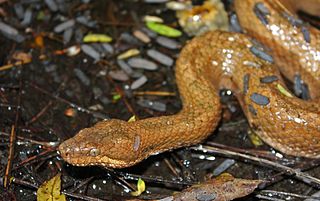Fossils
Fossils of 10 extinct species in five genera [6] from the Paleocene, Eocene, and Oligocene of Europe, Africa, and North and South America have been assigned to the Tropidophiidae, although all of them are probably actually either ungaliophiines or stem afrophidians. Two genera, Falseryx and Rottophis, both from the Oligocene of western Europe, have some similarities with living tropidophiids [7] as well as with ungaliophiines, but for the most part their skulls are poorly preserved, leaving paleontologists to work on just their vertebrae. Paleogene erycines dominated the snake fauna of North America prior to the Miocene explosion of colubroids, but as far as we know all of these species were much more closely related to modern rosy and rubber boas than they were to tropidophiids. The only unequivocal tropidophiid fossils are from the Pleistocene of Florida [8] and the Bahamas. [9]

The Boidae, commonly known as boas or boids, are a family of nonvenomous snakes primarily found in the Americas, as well as Africa, Europe, Asia, and some Pacific islands. Boas include some of the world's largest snakes, with the green anaconda of South America being the heaviest and second-longest snake known; in general, adults are medium to large in size, with females usually larger than the males. Six subfamilies comprising 15 genera and 54 species are currently recognized.

Tropidophis melanurus, commonly known as the dusky dwarf boa, Cuban wood snake, or Cuban giant dwarf boa, is a nonvenomous dwarf boa species endemic to Cuba. There are three subspecies that are recognized as being valid, including the nominate subspecies described here.

Tropidophis, common name Caribbean dwarf boas, wood snakes or West Indian wood snakes, is a genus of dwarf boas endemic to the West Indies and South America. Currently, either 17 or 33 species are recognized, depending on the authority.
Tropidophis fuscus is a nonvenomous dwarf boa species endemic to Cuba. There are no subspecies that are recognized as being valid.
Tropidophis morenoi, also commonly known as the zebra dwarf boa and the zebra trope, is a species of snake in the family Tropidophiidae. The species is endemic to the West Indies.
Tropidophis hendersoni, commonly known as the Cuban khaki dwarf boa, the Cuban Khaki Trope, and Henderson's trope, is a species of snake in the family Tropidophiidae. The species is endemic to Cuba.
Tropidophis greenwayi is a nonvenomous dwarf boa species endemic to the Caicos Islands. Two subspecies are currently recognized, including the nominate subspecies described here.

The Bahamian pygmy boa constrictor, also known as the Inagua trope or Bahama wood snake, is a species of nonvenomous snake in the family Tropidophiidae. The species is endemic to Great Inagua Island in the Bahamas.

Tropidophis feicki, also known commonly as the broad-banded dwarf boa, the broad-banded trope, and Feick's dwarf boa, is a species of non-venomous snake in the family Tropidophiidae. The species is endemic to Cuba.
Tropidophis haetianus, the Haitian dwarf boa, is a species of snake in the family Tropidophiidae. The species is endemic to the island of Hispaniola in the West Indies.
Tropidophis maculatus, or the spotted red dwarf boa, is a species of snake in the family Tropidophiidae. The species is endemic to Cuba.
Tropidophis nigriventis, or the black-bellied dwarf boa, is a species of snake in the family Tropidophiidae. The species is endemic to Cuba.
Tropidophis pardalis, also known commonly as the leopard dwarf boa and the spotted brown trope, is a species of snake in the family Tropidophiidae. The species is endemic to Cuba.

Tropidophis paucisquamis, or the Brazilian dwarf boa, is a species of snake in the family Tropidophiidae. The species is endemic to Brazil.
Tropidophis pilsbryi, commonly known as Pilsbry's dwarf boa or the Cuban white-necked dwarf boa, is a species of snake in the family Tropidophiidae. The species is endemic to Cuba.

Tropidophis taczanowskyi, also known commonly as Taczanowski's dwarf boa, is a species of snake in the family Tropidophiidae. The species is native to northern South America.
Tropidophis wrighti, commonly known as Wright's dwarf boa, the gracile banded dwarf boa, and the gracile banded trope, is a species of snake in the family Tropidophiidae. The species is endemic to Cuba.

Ungaliophiinae is a subfamily of booid snakes containing two genera, Ungaliophis and Exiliboa. They are small constrictors that are found in Central and South America from southern Mexico to Colombia. They eat mostly lizards and frogs and have been poorly studied.

Tropidophis stejnegeri, also known commonly as Stejneger's dwarf boa and the Jamaican eyespot trope, is a small species of snake in the family Tropidophiidae. The species is endemic to the northern half of Jamaica.










